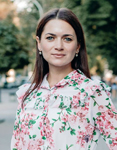Abstract
The article analyzes possibilities and necessity of using webinar service for teaching Ukrainian language as foreign to students in higher medical educational institutions. The urgency of the material described in this article, is due to urgent needs of detailed and systematic analysis of modern approaches to the educational process of the current distance form of learning actively using webinar as a modern form of distance learning. It was determined that the proper organization of the virtual learning space creates adequate perception of the educational material by foreign students, differentiates forms of teaching material supply and provide its adequate level of openness and accessibility. The main reasonableness to combine the best achievements of the traditional educational system and innovative pedagogical technologies was found out. This reasonableness was motivated for teaching Ukrainian and foreign students who have already chosen medical profession. Difficult process of effective application of the distance learning form, the usage of combined training forms for foreign students in the virtual linguistic space were described. The theoretical foundations of the research of pedagogical innovations were systematized, the current state of study of the phenomenon of the webinar was outlined and the views of scientists on it was generalized. It was determined that webinar was an interactive network form of studying. The main feature of webinar is the usage of information and software resources. The article emphasis on the fact that a webinar is an on-line lecture (seminar). Webinar helps to develop linguistic, linguistic and socio-cultural competencies of students. Means of monitoring students' achievements were analyzed. In addition, the necessary conditions for the successful conduct of the webinar were outlined. Difficulties of usage webinars during the study of the Ukrainian language as a foreign language were set out. Steps to overcome these difficulties were recommended. It was discovered practical problems that need solving during implementation webinars during the study of the discipline « Ukrainian language as foreign ».
References
Т. О. Лещенко, Мовленнєвий портрет сучасного лікаря (лінгвопрагматичний аспект). Актуальні питання суспільних наук та історії медицини, №1 (17), с. 10–15, 2018.
С. Д. Калинина,«Вебинар как форма электронного обучения в высшей школе», Вестник МГИМО Университета, № 2 (41), с. 291–295, 2015.
А. В. Конышева,«Вебинар как сетевая форма организации учебной деятельности студентов», Научно-методический электронный журнал «Концепт», №1, с. 86–90, 2016.
Н. В. Морзе, «Методичні особливості вебінарів, як інноваційної технології навчання», Інформаційні технології в освіті : зб. наук. пр. Херсон : ХДУ, №. 5, с. 31–39, 2010.
Д. Ю. Динцис,«Методические особенности проведения вебинаров на краткосрочных курсах по методике «in-class». [Електронний ресурс]. Доступно: http://www.trainings.ru/library/articles/?id=13183.
Ю. В Фролов,«Подготовка и проведение вебинаров : учебно-методическое пособие для преподавателей, студентов и слушателей системы повышения квалификации», М.,Росия, МГПУ, с. 30, 2011.
М. М. Жовнір,«Коучинг-технології на заняттях мовного циклу: до питання впровадження і контролю навчальних досягнень студентів», Актуальні питання контролю якості освіти у вищих навчальних закладах : матер. науково-практичної конференції, Полтава, 22 березня 2018 р., Полтава : ВДНЗУ «УМСА», с. 91–93, 2018.
REFERENCES (TRANSLATED AND TRANSLITERATED)
T. O. Leschenko, «The linguistic portrait of a modern physician (linguistic and pragmatic aspect)» Movlenneviy portret suchasnogo lIkarya (lIngvopragmatichniy aspekt), Aktualni pitannya suspilnih nauk ta istoriyi meditsini, 1 (17), p. 10–15, 2018 (in Ukrainian).
S. D. Kalinina, «Webinar as a form of e-learning in higher education», Vestnik MGIMO Universiteta, p. 291–295 (in Russian).
A. V. Konyisheva, «Webinar as a Network Form for the Organization of Educational Activities of Students», Scientific and Methodical Electronic Journal «Concept», №1, p. 86–90, 2016 (in Russian).
N. V. Morze, «Methodical features of webinars as an innovative learning technology», Informatsiy I tehnologiyi v osvItI :zb. nauk. pr., Herson, HDU, №. 5, p. 31–39, 2010 (in Ukrainian).
D. Y. Dintsis,«Methodical features of conducting webinars on short-term courses in the» in-class» method, [Online]. Available:http://www.trainings.ru/library/articles/?id=13183 (in Russian).
Y. V Frolov, «Preparation and conducting of webinars: educational and methodical manual for teachers, students and students of the system of improvement of professional skills», M., RosIya, MGPU, p. 30, 2011 (in Russian).
M. M. Zhovnir, «Coaching technologies in the language cycle: to the introduction and control of student achievements», Aktualni pitannya kontrolyu yakosti osviti u vischih navchalnih zakladah : mater. naukovo-praktichnoyi konferentsiyi, Poltava, 22 bereznya 2018 r., Poltava, VDNZU «UMSA» (in Ukrainian).
Authors who publish in this journal agree to the following terms:
- Authors hold copyright immediately after publication of their works and retain publishing rights without any restrictions.
- The copyright commencement date complies the publication date of the issue, where the article is included in.
Content Licensing
- Authors grant the journal a right of the first publication of the work under a Creative Commons Attribution-NonCommercial-ShareAlike 4.0 International License (CC BY-NC-SA 4.0) that allows others freely to read, download, copy and print submissions, search content and link to published articles, disseminate their full text and use them for any legitimate non-commercial purposes (i.e. educational or scientific) with the mandatory reference to the article’s authors and initial publication in this journal.
- Original published articles cannot be used by users (exept authors) for commercial purposes or distributed by third-party intermediary organizations for a fee.
Deposit Policy
- Authors are permitted and encouraged to post their work online (e.g., in institutional repositories or on their website) during the editorial process, as it can lead to productive exchanges, as well as earlier and greater citation of published work (see this journal’s registered deposit policy at Sherpa/Romeo directory).
- Authors are able to enter into separate, additional contractual arrangements for the non-exclusive distribution of the journal's published version of the work (e.g., post it to an institutional repository or publish it in a book), with an acknowledgement of its initial publication in this journal.
- Post-print (post-refereeing manuscript version) and publisher's PDF-version self-archiving is allowed.
- Archiving the pre-print (pre-refereeing manuscript version) not allowed.


